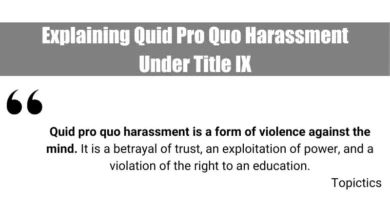Quid Pro Quo Sexual Harassment Definition, Implications
Takeaways
| Key Points |
|---|
| Quid pro quo sexual harassment involves employment decisions contingent on unwelcome sexual advances or conduct. |
| Title VII of the Civil Rights Act of 1964 addresses quid pro quo harassment as a form of sex discrimination. |
| Key cases include Meritor Savings Bank v. Vinson, Burlington Industries, Inc. v. Ellerth, and Faragher v. City of Boca Raton, which shaped legal interpretations and employer liability. |
| Victims experience emotional distress and anxiety, and workplace morale and productivity suffer. |
| Employers should establish clear policies, provide training, offer complaint mechanisms, conduct prompt investigations, and enforce disciplinary actions. |
| The #MeToo movement highlighted the prevalence of quid pro quo harassment and the need for systemic change. |
| Victims may hesitate to report due to fear of retaliation or damage to their reputation, and power dynamics can complicate the resolution process. |
| HR should develop policies, provide training, handle complaints, and support victims to prevent and address harassment effectively. |
| Victims can file complaints with the EEOC or pursue legal action in civil court for compensation and punitive damages. |
Definition and Characteristics
Quid pro quo sexual harassment occurs when employment decisions or benefits are contingent upon an employee’s submission to unwelcome sexual advances or conduct.
This form of harassment is marked by a power imbalance, typically involving a supervisor or person in authority and a subordinate. The term “quid pro quo” itself translates to “this for that,” underscoring the transactional nature of this type of harassment.

Legal Framework
The legal framework for addressing quid pro quo sexual harassment primarily stems from Title VII of the Civil Rights Act of 1964 in the United States. Title VII prohibits employment discrimination based on race, color, religion, sex, and national origin. Sexual harassment, including quid pro quo harassment, is considered a form of sex discrimination.
To establish a quid pro quo harassment claim, the following elements generally must be proven:
- The employee was subjected to unwelcome sexual advances, requests for sexual favors, or other verbal or physical conduct of a sexual nature.
- Submission to such conduct was explicitly or implicitly made a term or condition of employment.
- The employee’s submission to or rejection of such conduct was used as the basis for employment decisions affecting the employee.

Notable Legal Cases
Several landmark cases have shaped the legal landscape of quid pro quo sexual harassment:
1. Meritor Savings Bank v. Vinson (1986):
The Supreme Court recognized sexual harassment as a violation of Title VII and held that an employer could be held liable for the actions of its employees. The case involved allegations of both quid pro quo and hostile work environment harassment.
2. Burlington Industries, Inc. v. Ellerth (1998):
This case clarified the distinction between quid pro quo and hostile work environment harassment. The Court held that an employer is liable for a supervisor’s sexual harassment even if the employee did not suffer a tangible employment action, provided the employer did not exercise reasonable care to prevent and correct the harassment, and the employee unreasonably failed to take advantage of any preventive or corrective opportunities.
3. Faragher v. City of Boca Raton (1998):
The Court reinforced the principles established in Ellerth, emphasizing the employer’s responsibility to prevent and address harassment. The ruling highlighted the importance of effective anti-harassment policies and procedures.
Impact on Employees and Workplace Dynamics
Quid pro quo sexual harassment has profound effects on employees and workplace dynamics. Victims often experience emotional distress, anxiety, and a sense of powerlessness. The fear of retaliation or job loss can deter victims from reporting the harassment, allowing the behavior to persist.
Workplace morale and productivity can also suffer. When employees perceive that their colleagues are subjected to quid pro quo harassment, it can lead to a toxic work environment. Trust in management erodes, and the overall organizational culture can become compromised.
Preventive Measures and Employer Responsibilities
Employers have a legal and ethical obligation to prevent and address quid pro quo sexual harassment. Key preventive measures include:
- Clear Anti-Harassment Policies: Employers should establish and disseminate comprehensive policies that clearly define quid pro quo harassment and outline the procedures for reporting and addressing complaints.
- Training and Education: Regular training sessions for employees and supervisors can help raise awareness about sexual harassment and reinforce the organization’s commitment to a safe and respectful workplace.
- Effective Complaint Mechanisms: Employers should provide multiple channels for employees to report harassment, ensuring confidentiality and protection against retaliation.
- Prompt and Thorough Investigations: Employers must investigate all harassment complaints promptly and thoroughly. Investigations should be conducted impartially and with respect for all parties’ privacy.
- Disciplinary Actions: Employers should enforce appropriate disciplinary actions against individuals guilty of harassment. This reinforces the message that such behavior will not be tolerated.
Broader Social Implications
Quid pro quo sexual harassment extends beyond the immediate workplace, influencing broader social dynamics and public trust. High-profile cases often garner significant media attention, prompting public discourse about the prevalence of sexual harassment and the need for systemic change.
The #MeToo movement, which gained momentum in 2017, brought to light numerous instances of quid pro quo harassment across various industries. The movement highlighted the pervasive nature of sexual harassment and the importance of supporting survivors and holding perpetrators accountable.

Challenges in Addressing Quid Pro Quo Harassment
Despite legal protections and increased awareness, addressing quid pro quo sexual harassment remains challenging. Victims may hesitate to report harassment due to fear of retaliation, damage to their professional reputation, or disbelief that their complaints will be taken seriously.
Moreover, power dynamics within organizations can complicate the reporting and resolution process. Individuals in positions of authority may exploit their power to intimidate or silence victims.
This underscores the importance of strong organizational policies and leadership that foster respect and accountability.
The Role of Human Resources

Human Resources (HR) is critical in preventing and addressing quid pro quo sexual harassment. HR professionals are often the first point of contact for employees seeking to report harassment. As such, they must have the knowledge and skills to handle complaints sensitively and effectively.
HR departments should prioritize the following:
- Policy Development and Implementation: HR should lead the development and implementation of anti-harassment policies, ensuring they are comprehensive and accessible to all employees.
- Training Programs: HR should coordinate regular training sessions on sexual harassment prevention, emphasizing the seriousness of quid pro quo harassment and the consequences for perpetrators.
- Complaint Handling and Investigations: HR should establish clear procedures for handling harassment complaints and conduct investigations impartially and thoroughly.
- Support for Victims: HR should provide support and resources for victims of harassment, including counseling services and assistance in navigating the complaint process.
Legal Recourse for Victims
Victims of quid pro quo sexual harassment have several avenues for legal recourse. They can file a complaint with the Equal Employment Opportunity Commission (EEOC), responsible for enforcing federal laws against employment discrimination. The EEOC investigates complaints and can act against employers who violate the law.
Victims may also pursue legal action in civil court. Successful claims can result in compensation for damages, including lost wages, emotional distress, and legal fees. In some cases, courts may also order punitive damages to punish particularly egregious behavior and deter future misconduct.
Conclusion
Quid pro quo sexual harassment is a serious and pervasive issue that undermines the integrity of the workplace and the well-being of employees.
Legal frameworks, such as Title VII of the Civil Rights Act, provide crucial protections for victims, but addressing harassment requires concerted efforts from employers, HR professionals, and society.
Preventive measures, including clear policies, regular training, and effective complaint mechanisms, are essential for creating a safe and respectful work environment. Employers must take their responsibilities seriously and act swiftly to address harassment complaints, reinforcing a zero-tolerance stance against such behavior.
The broader social implications of quid pro quo harassment highlight the need for ongoing public discourse and systemic change.
By supporting survivors, holding perpetrators accountable, and fostering a culture of respect and accountability, we can work towards a future where all employees feel safe and valued in their workplaces.
FAQ
Can quid pro quo harassment be non-sexual?
Yes, quid pro quo harassment can be non-sexual. While it is commonly associated with sexual harassment, quid pro quo harassment can also involve other forms of coercion, such as demanding personal favors, services, or specific behaviors in exchange for job benefits or to avoid negative employment actions.
How can employees protect themselves from quid pro quo harassment?
Employees can protect themselves by being aware of their rights and the company’s anti-harassment policies. They should document any incidents of harassment, including dates, times, locations, and witnesses. Reporting harassment to HR or a designated company representative as soon as possible is crucial. Seeking support from trusted colleagues, professional organizations, or legal counsel can also be beneficial.
What role does workplace culture play in preventing quid pro quo harassment?
Workplace culture plays a significant role in preventing quid pro quo harassment. A culture that promotes respect, equality, and open communication can deter harassment behaviors. Companies should foster an inclusive environment where employees feel safe reporting harassment without fear of retaliation. Leadership commitment to enforcing anti-harassment policies and setting a positive example is essential for cultivating a harassment-free workplace.
Are employers liable for quid pro quo harassment committed by non-employees?
Employers can be liable for quid pro quo harassment committed by non-employees, such as clients, contractors, or vendors if they knew or should have known about the harassment and failed to take appropriate corrective action. Employers are responsible for maintaining a safe work environment, which includes addressing harassment from any source within the workplace.









